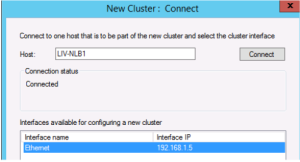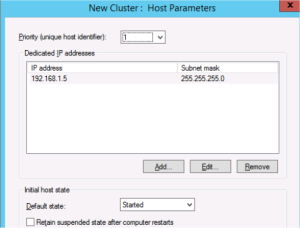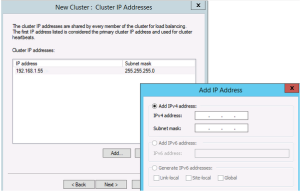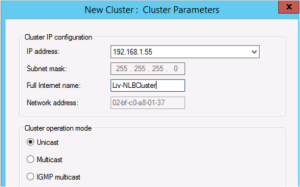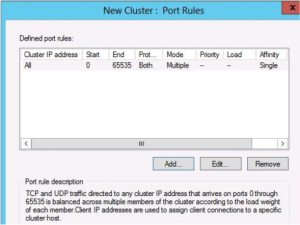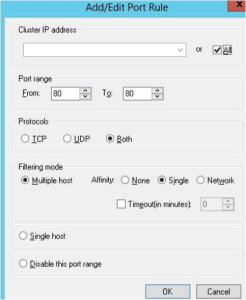As part of my preparation for the 70-412 Microsoft Exam, I needed to learn about Network Load Balancing Clusters. To do this I built one in my test lab and documented the process. The details below should be a useful reference for production environments, and for exam revision. Enjoy….
Network Load Balancing improves the availability of services by absorbing individual server failures and hiding these from the clients.
Automatically detects servers that are unresponsive or disconnected from the network and redistributes the new client requests to other nodes in the cluster
Supports adding more servers as the demand for the services grows
Mainly used with IIS and web services, stateless
Changes made on one node are not automatically replicated to other servers in the cluster, Use NLB to support stateless applications (IIS Servers) DO NOT USE WITH stateful applications such as database servers.
- To create a new cluster open the Tool and select “New Cluster”
- (New Cluster: Connect) Connect to the first host in the new cluster
- (New Cluster: Connect) Choose the interface on the server to use for NLB traffic. In production environment you would normally want to reserve a dedicated NIC for NLB traffic.
- (New Cluster: Host Parameters) Host Priority (unique host identifier) – Value from 1 to 32 assigned to an individual cluster node. 1 is the highest. Determines which NLB node will handle network traffic not load balanced (not covered by port rules)
- (New Cluster: Host Parameters) Dedicated IP Addresses – Local IP address used by the node to connect to the cluster. Not assigned to the cluster, used by local host only.
- (New Cluster: Host Parameters) Initial Host State – Default state of the local node (Started, Suspended or Stopped) Option to retain suspended state after restart.
- (New Cluster: Cluster IP Addresses) Cluster IP Addresses – Configure the virtual IP addresses that will be assigned to the entire server farm or cluster
- (New Cluster: Cluster Parameters) Cluster IP Configuration – Configure the clusters IP address, subnet mask, FQDN, MAC address
- (New Cluster: Cluster Parameters) Cluster Operation Mode – Unicast, Multicast, IGMP Multicast
- Unicast – Allows cluster MAC address to replace the host adapter MAC address. Does not work in some virtual environments.
- Always works, required no special N/W configurations
- Requires a 2nd NIC on NLB hosts
- Causes Subnet flooding
- Multicast – Each host adapter keeps it original MAC address
- Does not require a 2nd NIC
- Causes subnet flooding, requires special N/W configuration
- IGMP Multicast – Multicast configured at the IP address level, prevents switch flooding. Best solution in a production environment.
- Does not cause subnet flooding
- Does not require a 2nd NIC
- Requires network support, special N/W configuration
- Unicast – Allows cluster MAC address to replace the host adapter MAC address. Does not work in some virtual environments.
- (New Cluster: Configuring Port Rules) – Most important part of NLB.
- Define which traffic is load balanced
- Each port rule matches incoming traffic based on TCP or UDP Ports and (optionally) destination IP address
- Only one rule can every apply to an incoming packet (no issues with rule priority or order or conflicts)
- (New Cluster: Configuring Port Rules) – Default rule is predefined, covers all traffic on TCP / UDP ports between 0 – 65535
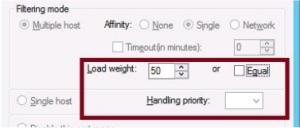 (New Cluster: Configuring Port Rules) – On the add/edit rule page ypu can edit the following
(New Cluster: Configuring Port Rules) – On the add/edit rule page ypu can edit the following
- Cluster IP Address – Edit the port rule so it only applies to one of the cluster addresses
- Port Range and Protocols – Define a range of one or more ports
- Protocols – TCP, UDP or Both
- Filtering Mode – Multiple Host, Single Host, Disable
- Multiple Host – Default mode, provides load balancing and fault tolerance for traffic matching the port rule.
- Affinity Mode – None, single & Network (How to manager traffic to the NLB Cluster)
- None – Client traffic is directed to any node in the cluster
- Single – Client1 connects to Node1, it will then keep connecting to Node1 in future, Client2 connects to Node2, and will continue connecting to Node2. Default setting
- Network – Connection based on the last octet of the clients IP address.
- Timeout Settings – Extends affinity setting, allows setting to be retained for a number of minutes. (items in a shopping cart)
- Single Host – Directs all matching traffic to the node with the highest priority. If that host fails traffic directed to the next highest.
- Disable this port Range – Have the NLB cluster drop all traffic on specified ports
- Multiple Host – Default mode, provides load balancing and fault tolerance for traffic matching the port rule.
Load Weight and Handling Priority only available when editing an existing port rule.
- Load Weight – Assign a disproportionate weight of workload to the host whose properties you are editing. Default is Equal. Assign a node a greater or lesser amount of traffic directed at the farm
- Handling Priority – Priority value used for traffic covered by the port rule, only available in single host filtering mode.
Remember the difference between HOST Priority & HANDLING Priority
Finally add a Host record in DNS for the name of the NLB Cluster, pointing to the shared IP address
Drain stop – Stop new sessions connecting to the cluster node and waits for existing session to clear, then you can perform maintenance on the node.
Upgrade – Rolling upgrade of a cluster, Drain stop the node, down the node and do the upgrade and then put the node back into the cluster, repeat process for the next node
To find this post or others like it, just search NLB or Certification from the home page
Thanks for reading
Admin – TechSupportPro | uk

